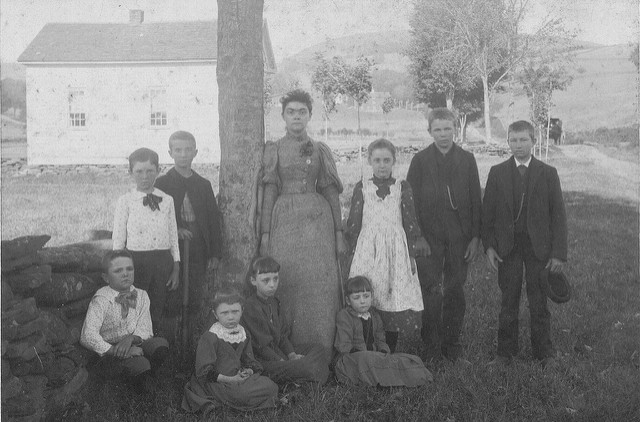Above: The Maynard School in Bovina. Photo by Stephen O’Grady.
Children once walked from their families’ far-flung farms to the Maynard School, a one-room schoolhouse in the Delaware County town of Bovina, cutting across fields to minimize the mileage. The white-painted clapboard structure on Bovina Road was built in 1849, and teachers held classes here until 1959, when the school closed.
But today the building, owned by the town of Bovina, is remarkably preserved, from the flagpole out front to the rows of low wooden desks facing the chalkboard inside. And on Saturday, June 4, four former students—who arrived via automobiles this time—were among approximately two dozen people attending the unveiling of a historic marker that was recently installed at the site.
“It’s the only one-room schoolhouse in Bovina that still looks like a one-room schoolhouse inside and out,” said Bovina historian Ray LaFever, who organized the event and kicked things off by giving a short talk on the history of schools in Bovina.
Above: Bovina historian Ray LaFever speaks at a ceremony at the Maynard School on June 4. Photo by Stephen O’Grady.
The Maynard School, so-named because it was built on the property of Elisha Maynard, an early settler of Bovina, was one of 13 small schoolhouses sprinkled throughout the area. The first was built in 1808. By 1820, when the town of Bovina was officially founded, there were five school districts, each with a corresponding schoolhouse. Of a population of around 1,200 that year, about 400 were children aged five to 15, and over half of them attended school. By the 1850s, Bovina had its full complement of 13 schools.
Typically, there were summer and winter sessions. Usually, a female teacher taught in the summer term and a male teacher oversaw the winter term when older boys, who worked the fields during the summer, joined the student body. (It was believed that the male teachers were needed to handle the older boys, according to LaFever.)
After the 1860s, Bovina's population declined, and so did its number of schoolchildren. The population loss, combined with an effort by New York State to consolidate schools, resulted in the closing of Bovina’s one-room schoolhouses and the transfer of students to larger schools in Andes and Delhi.
In 1923, Bovina’s Yankeetown School on Cape Horn Road burned to the ground on Halloween night. It is not known whether a prankster or a disgruntled student was involved, but that school’s children began attending the Maynard School.
Above: Former students who went to school in the Maynard School pose by an historical marker at the site on June 4. From left, they are Richard Parsons, Jean Merenberg, Rosemary Goedel Stewart and John Weber. Photo by Stephen O’Grady.
By the 1950s, the Maynard School was one of only two Bovina schools left.
John Weber, a resident of Oneonta who was present at the ceremony on Saturday, attended the Maynard School in 1955 and 1956. He remembered learning that four times four equals 16.
Other former students reminisced about less academic matters. Jean Merenberg, of Schenectady, New York, and Richard Parsons, who drove in from Harrisburg, Pennsylvania, recalled playing KEELY-EYELY OVER, a game in which they threw a ball back and forth over the roof of the schoolhouse.
They also remembered digging caves in snowdrifts in winter and said they had to hang their slingshots on a fence outside the school before entering the classroom. (Slingshots weren’t allowed inside.) Merenberg went on to become a nursery school teacher; Parsons is now an engineer.
After the Maynard School closed, only one Bovina school remained in operation: the District 4 school, in Bovina Center. Built in 1893, it was a two-room schoolhouse with younger students in one class and older ones in the other. The school closed in 1961 and is now the Bovina Public Library.
Most of the remaining schools are now private homes, many of them unrecognizable as schools because they’ve been renovated and enlarged over the years.

Above: A Bovina Maynard School class in the early 1900s. Photo courtesy of Ray LaFever.
The Maynard School is closed for most of the year, but it opens for four days in August when the Bovina Historical Society holds a day camp there in which children pretend they are living in the year 1900—girls in long dresses, boys in short pants with suspenders.
“No juice boxes,” said LaFever.
The blue-and-yellow aluminum marker placed outside the school was cast at Greene Brass & Aluminum Foundry in Greene, New York, and painted at Catskill Castings in Bloomville. Funding for the sign was provided by a grant from the William G. Pomeroy Foundation under its Historic Roadside Marker Program.
For more information about the Bovina Historical Society day camp, contact Janine Bray at [email protected].










